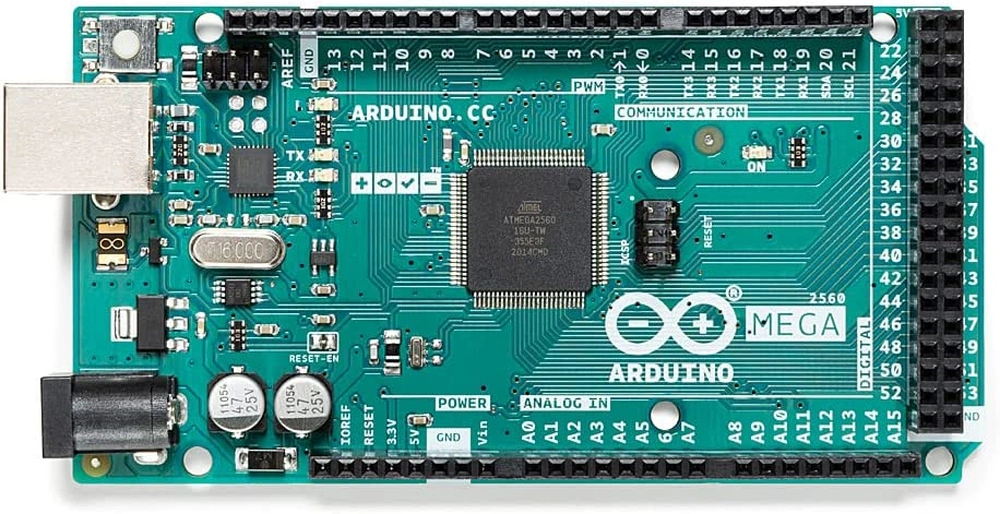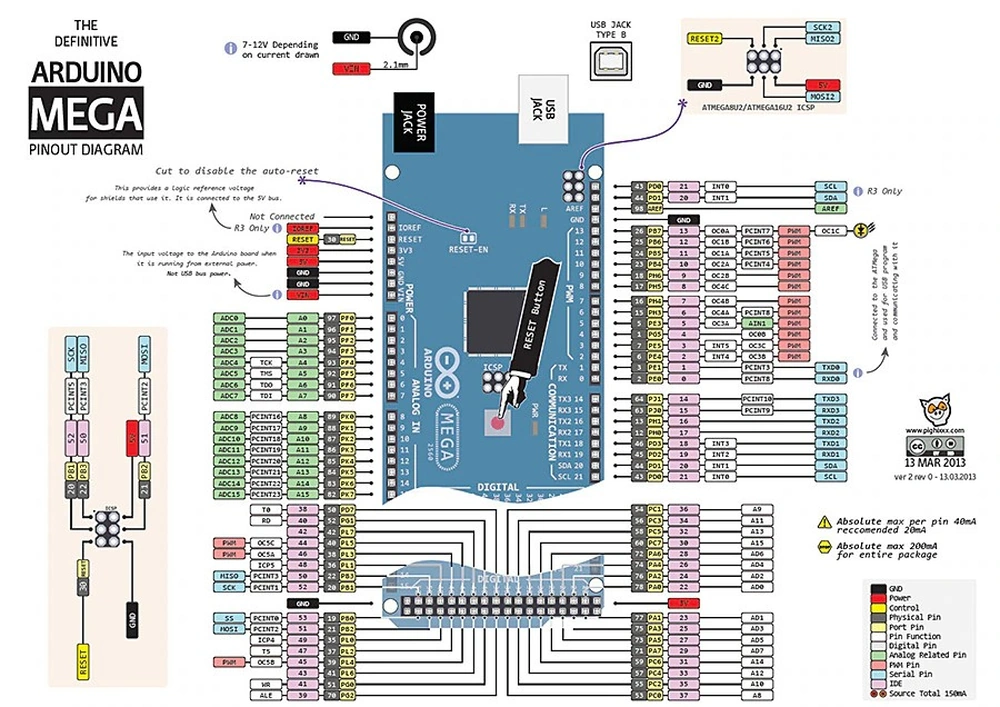
Table of Contents
Introduction
The Arduino Mega is a powerful microcontroller board that is designed to be used for more complex projects. It is based on the ATmega2560 microcontroller, which is a high-performance 8-bit AVR microcontroller with 256 KB of flash memory, 8 KB of SRAM, and 4 KB of EEPROM. With 54 digital input/output pins, 16 analog inputs, and a host of other features, the Arduino Mega is a versatile board that can be used for a wide range of projects.
If you need a quick reference to see how the Arduino Mega stacks up against other similar microcontrollers see the table here.
Specifications

The Arduino Mega has a wide range of specifications that make it a powerful microcontroller board. Here are some of the key specifications:
- Microcontroller: ATmega2560
- Operating Voltage: 5V
- Input Voltage: 7-12V (recommended)
- Digital I/O Pins: 54 (of which 15 provide PWM output)
- Analog Input Pins: 16
- DC Current per I/O Pin: 20 mA
- DC Current for 3.3V Pin: 50 mA
- Flash Memory: 256 KB of which 8 KB used by bootloader
- SRAM: 8 KB
- EEPROM: 4 KB
- Clock Speed: 16 MHz
- Digital I/O Pins
One of the key features of the Arduino Mega is its 54 digital input/output pins. These pins can be used for a wide range of applications, such as reading sensors, controlling LEDs, and communicating with other devices. Of the 54 pins, 15 provide PWM output, which is useful for controlling the brightness of LEDs or the speed of motors.
Analog Input Pins
The Arduino Mega has 16 analog input pins, which can be used to read analog sensors such as temperature sensors, light sensors, and potentiometers. These analog input pins have a resolution of 10 bits, which means they can detect 1024 different levels of analog input.
Communication Interfaces

The Arduino Mega has a range of communication interfaces, including four UARTs (hardware serial ports), SPI (Serial Peripheral Interface), and I2C (Inter-Integrated Circuit). These communication interfaces allow the Arduino Mega to communicate with other devices, such as sensors, displays, and other microcontrollers.
Memory
The Arduino Mega has 256 KB of flash memory, which is used to store the program code. It also has 8 KB of SRAM, which is used for variables and other data that the program needs to store. In addition, it has 4 KB of EEPROM, which can be used to store data that needs to be retained even when the power is turned off.
Power
The Arduino Mega can be powered in several ways. It can be powered via the USB connection, which provides 5V of power. It can also be powered using a DC power jack, which can accept input voltages from 7-12V. Finally, it can be powered using the VIN pin, which can accept input voltages up to 12V.
Compatibility

The Arduino Mega is compatible with most shields designed for the Arduino Duemilanove or Uno, which makes it a versatile choice for a wide range of projects. Shields are add-on boards that can be used to add additional functionality to the Arduino, such as Ethernet connectivity, motor control, or GPS.
Programming
The Arduino Mega can be programmed using the Arduino Integrated Development Environment (IDE), which is a free software development environment that is available for Windows, Mac, and Linux. The IDE provides a simple interface for writing and uploading code to the Arduino Mega, as well as a range of libraries and examples to help get started with programming. You can find an in-depth guide for the Arduino Mega here.
Conclusion
The Arduino Mega is a powerful microcontroller board that is suitable for a wide range of projects. With its 54 digital input/output pins, 16 analog inputs, and communication interfaces such as UART, SPI, and I2C, the Mega offers a high level of versatility for projects that require complex functionality. Its compatibility with shields designed for the Arduino Duemilanove or Uno also makes it a popular choice for those looking to extend the functionality of their projects.
The Mega also offers a significant amount of memory, with 256 KB of flash memory, 8 KB of SRAM, and 4 KB of EEPROM. This allows for the creation of more complex programs and data storage requirements. Additionally, the Mega can be powered in multiple ways, offering flexibility in how it can be used.
Programming the Mega is also straightforward with the Arduino IDE, which provides a simple interface for writing and uploading code to the board. The IDE also includes a range of libraries and examples to help get started with programming.
Overall, the Arduino Mega is a powerful and versatile microcontroller board that can be used for a wide range of projects. Its numerous digital input/output pins, analog inputs, communication interfaces, and memory capabilities make it a popular choice for those looking to create more complex projects. With the ability to be powered in multiple ways and programmed using the Arduino IDE, the Mega offers a high level of flexibility and ease of use.
Need to compare microcontrollers for a project? See the table here.
Want to use an Arduino for an input device with your PC? Click there.
Go here, for all of our Arduino Related articles, or all of our microcontroller series which covers Arduino and a whole lot more.